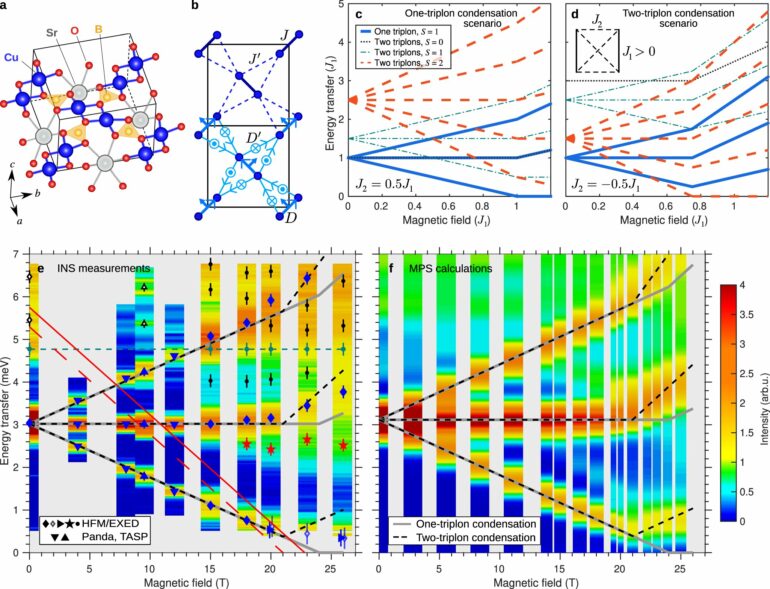In the mysterious world of quantum materials, things don’t always behave as we expect. These materials have unique properties governed by the rules of quantum mechanics, which often means that they can perform tasks in ways traditional materials cannot—like conducting electricity without loss—or having magnetic properties that may prove useful in advanced technologies.
Some quantum materials feature tiny magnetic waves called magnons running through them, which behave in puzzling ways. Understanding magnons helps us unlock secrets of how magnets work at a microscopic level, which is crucial for the next generation of electronics and computers.
Scientists have been studying how these magnons act under strong magnetic fields, and they thought they knew what to expect—until now. In a new study in Nature Communications, researchers led by Henrik Rønnow and Frédéric Mila at EPFL have unveiled a new, unexpected behavior in the quantum material strontium copper borate, SrCu2(BO3)2. The study challenges our current understanding of quantum physics but also hints at exciting possibilities for future technologies.
The only game in town
But why this material? The specifics are quite technical, but SrCu2(BO3)2 is important in the field of quantum materials because it is the only known real-world example of the “Shastry-Sutherland model,” a theoretical framework for understanding structures where the arrangement and interactions of atoms prevent them from settling into a simple, ordered state.
These structures are known as “highly frustrated lattices” and often give the quantum material complex, unusual behaviors and properties. So, the unique structure of SrCu2(BO3)2 makes it an ideal candidate for studying complex quantum phenomena and transitions.

The 25.9 Tesla magnet and neutron spectrometer at the research facility at the Helmholtz-Zentrum Berlin. © Ellen Fogh (EPFL)
Neutron scattering and massive magnetic fields
To study the magnons in SrCu2(BO3)2, the scientists used a technique called neutron scattering. Essentially, they fired neutrons at the material, and measured their deflections off it. Neutron scattering is particularly effective in studying magnetic materials, since neutrons, being neutral in charge can decipher magnetism without being disturbed by the charge of electrons and nuclei in the material.
This work was carried out at the high-field neutron scattering facility at Helmholtz-Zentrum Berlin, which was capable of probing fields up to 25.9 Tesla, making this an unprecedented level of magnetic field study, that allowed the scientists to observe the magnons’ behavior directly.
They then combined the data with “cylinder matrix-product-states” calculations, a powerful computational method that helped confirm the experimental observations from the neutron scattering and understand the material’s two-dimensional quantum behaviors.
It takes two to tango
The unique approach revealed something surprising: instead of behaving as single, independent unities—as expected—the material’s magnons were pairing up, forming “bound states”—like pairing up to dance instead of going solo.
This unusual pairing leads to a new, unexpected quantum state that has implications for the material’s properties: the “spin-nematic phase.” Think of it like magnets on a fridge: normally, they point north or south (that’s the spin), but this new phase is not about the direction to which they point, but rather how they align with each other, creating a unique pattern.
This discovery reveals a behavior in magnetic materials never seen before. This uncovering of a hidden rule in quantum physics might lead us to new ways to use magnetic materials for quantum technologies that we haven’t even thought of yet.
More information:
Ellen Fogh et al, Field-induced bound-state condensation and spin-nematic phase in SrCu2(BO3)2 revealed by neutron scattering up to 25.9 T, Nature Communications (2024). DOI: 10.1038/s41467-023-44115-z
Provided by
Ecole Polytechnique Federale de Lausanne
Citation:
Scientists reveal mysterious and unique behavior in a quantum magnetic material (2024, January 24)



